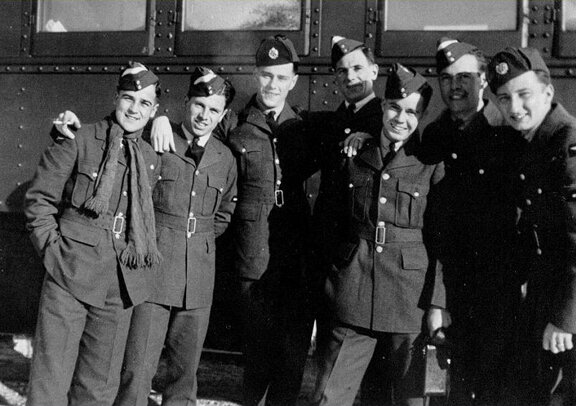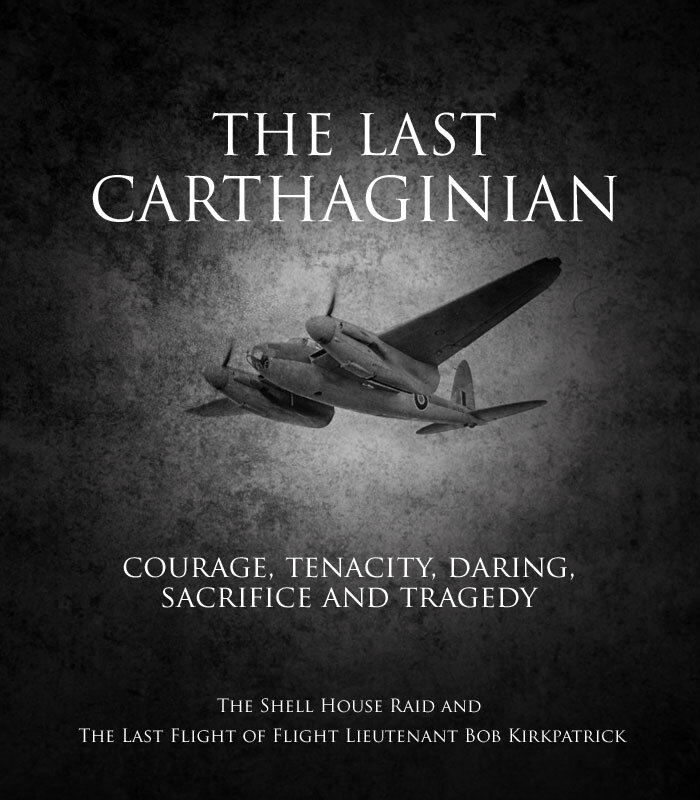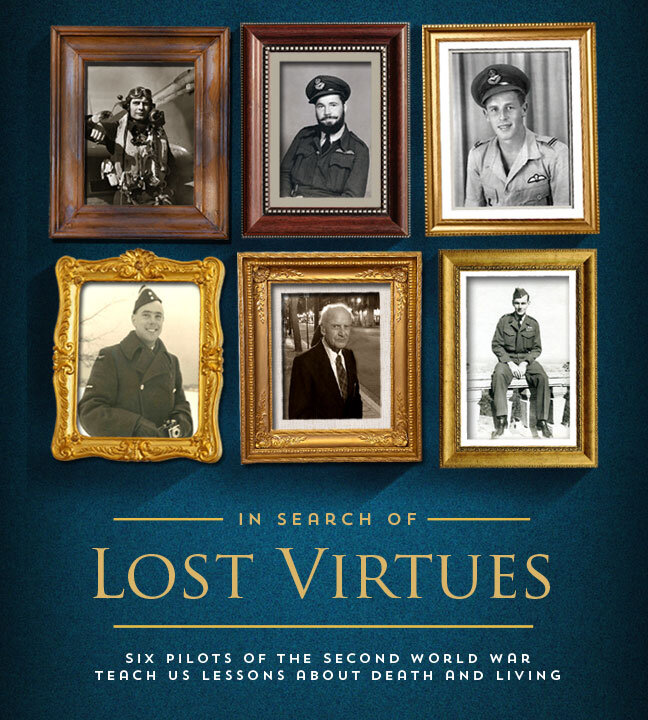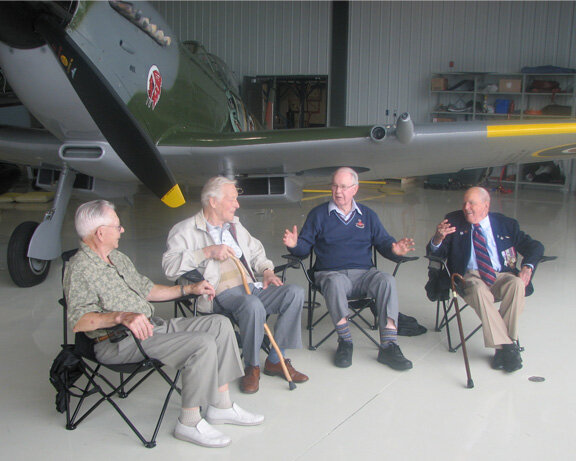REQUIEM FOR A WINGMAN
Bill McRae carried this photo of himself on his person on the day described herein. Called an "escape photo", pilots operating deep over enemy-held territory were required to have a portrait photo in civilian clothing to provide to resistance fighters. This photo would then be used in phony transit documents. Just how Scottish-born and Canadian raised McRae would fool German authorities into believing he was a Frenchman is not known. Photo Bill McRae
The weather on July 26th, 1944 was clear, warm, and windy from the Normandy coast all the way to Paris. It was a good day for hunting and 401 Squadron was up for the second time that day. Pushing closer and closer to Paris each day, they could sense an impending collapse of the Luftwaffe's ability to fight. Today, Squadron Leader Irving “Hap” Kennedy was leading his men high and deep over enemy territory in an effort to draw black crosses up to a fight. The goal today was to engage the Germans over their own fields to keep them from harassing RAF and American bombers pounding away at St. Lo, a hundred miles to the east.
A hundred feet or so behind Hap, and to his left, was Spitfire YO-L piloted by Flight Lieutenant Bill McRae, his wingman for today. McRae was a highly experienced, highly motivated and incredibly cheerful pilot and Kennedy as squadron leader considered himself fortunate to have him covering his six on this op as he himself was gifted section leader himself.
The air at nine thousand feet was surprisingly lively and McRae's Spitfire yo-yoed and twitched happily as he held loose formation on his lead. Ahead and all around him, the 401 Spits rose and fell like fish in a fast moving stream. Like all pilots during thew war, there were days when the young McRae felt out of synch with his Spitfire; where getting home safely was the only positive thing he took from a mission. But lately, flying every day for almost two months, those trips were fewer and farther between. Today, he wore his Spitfire like a suit of armour. Today YO-L's beautiful elliptical wings were the outstretched lengths of McRae's arms and the ailerons hummed like his own fingertips in the slipstream. Inside the hot confines of the cockpit, he rolled his shoulders in succession, opened and closed his hands and pushed up against his shoulder belts to release some stress. He smiled behind his oxygen mask.
While he kept his mind and his eyes primarily on Kennedy in YO-A, he constantly snatched glances high and low on both sides, looking for telltale specs against the sky or wing flashes against the landscape below. Ahead, he could see Kennedy's head moving from side to side. Every now and then Kennedy would turn his shoulders hard to the left and look back at McRae, nodding sharply. McRae bobbed his head each time in acknowledgment.
Though the thunder and heat of the Merlin behind which he was strapped was oppressive, Bill McRae was so used to it, he hardly noticed. Instead he listened for the voice of Kennedy through the sweat, crackle and hiss of his helmet and to his own thoughts as he checked and rechecked his instruments. He could taste his lunch of fried eggs and bacon, smell the oily rubber, feel his spine humming in harmony with twelve massive cylinders.
The breadth of western France south of Paris spread out in a haze below them. Fields, villages, highways and rail lines stood sharply beneath, but fused into soft grey blue towards the horizon. Looking up, McRae saw dozens of streaming parallel contrails leading from the English Channel north of their position, each with a spark of wing-struck sunlight at the head. They were more than fifty miles away he calculated, heading for rail yards to the northeast of Paris.
One day soon, he hoped to walk the avenues of Paris with Hap and the boys. Now, that would be something. The way things were going they would be there in a month he thought.
Bill McRae (third from right) and six of his Portage La Prairie EFTS buddies are about to board a train at the town of Fort William (Now Thunder Bay), bound for southern Ontario, the war and, for five of the seven, their deaths in combat. It is the winter of 1940-41 and the day is sharp and clear. There is much bravado on the faces of these boys, but Bill's face displays that humility and gentleness he exhibited to the day he died. In Bill's hand, we see a camera with which he would record many of the faces and events of his journey through hell. With his photos and logbooks, Bill would later be able to recall events and friends with great clarity and write vignettes of life among the warriors. Along with Bill, the only other pilot to survive the war was Omer Levesque (far left) who would go on the become a fighter ace and, in Korea, become the first Canadian to shoot down an enemy aircraft in jet-to-jet combat.
His headphones came alive as Kennedy called a sweeping left turn towards the outskirts of Paris. His attention was drawn to his squadron leader. With the light high and now off their port rear quarter, Hap's Spit came into sharp focus. The big letters YO-A were covered in oil and the dirt from the Beny-sur-mer airfield where 401 was based. Streaks of exhaust and filth ran down the side. Muddy boot prints ran up the side of Hap's port wing and McRae was struck by the incongruous image of footprints at this altitude. There were patches where shrapnel from close call flak detonations had punctured its skin and bright bare metal flecks where rough treatment on the ground had chipped the overpaint. Sunlight dazzled off Kennedy's propeller disc. Slung beneath was a pair of jettisonable long range tanks that enabled the Canadians to range far and wide. So far, so good.
Nearly two miles below, hidden beneath camouflage netting in a copse of French hardwood along a rail spur leading to the mainline between Le Mans and Paris, a Luftwaffe Feldwebel manning the instruments of a 3 meter Wurzberg radar had 401 in his grasp. Surrounding the dish three radar-guided 88 millimeter anti-aircraft guns with blackened barrels thrust through the netting opened up immediately upon getting 401's range and altitude. The first rounds sailed up towards the thin and pale blue aluminum bellies of the 401 Spitfires carrying the Canadians into battle. It was 1619 in the afternoon.
Caught in a peaceful, dream-like reverie brought on by the drone a long range sortie on a warm day and his comfort with the Spitfire, McRae was violently snapped awake when three explosions cracked the airspace ahead of him. One exploded just off the left wingtip of Kennedy almost in the line of flight for Bill, another somewhere to the right of Kennedy and a third exploded beneath the engine of Hap's Spitfire. Kennedy's aircraft bucked like a gut-shot deer while Bill flew into the chaotic air where the shell had exploded in his track, tossing him sharply up and to the left. Bits of Hap's dying Spitfire whipped past his right and Bill caught a millisecond snapshot of a violently tumbling exhaust stack. Bill heard something strike his Spit from below, but his instruments would continue to show that there was no critical damage.
Hap's Spitfire seemed to gasp and slow immediately and by the time Bill could react, he was alongside his lead and in a shallow dive to stay with him. Flames now ran from the opening where the exhaust had once emerged and from under the Spitfire's belly. From inside his own cockpit, Bill felt, rather than heard, the roar of the red blowtorch that seared down the sides of Hap's Spit. Greasy black smoke streamed aft. There were holes in Hap's port wing. For a few seconds, he watched as his friend seemed to be calmly assessing his situation with his head down in the cockpit... but after a few seconds, realized he had to act. "Get out Boss, you're on fire!" he shouted and slid his fighter farther away from Hap, partly to give him room to bail but also from a need to get away from the doomed Spitfire lest its demise engulf him too. Bill's heart was pounding out a fast drumbeat that seemed to say "Hurry, Hurry, Hurry..."
Hap seemed to be trimming up the Spitfire, getting set to go... Hurry Hurry Hurry... Kennedy's hand reached up for the canopy jettison knob above his head along the canopy rail. Bill could see him yank hard on it and see his hand slip off. The canopy stayed in place. Bill remembered hearing stories about how these knobs came away in pilots' hands or how they failed to release the canopy as advertised... Hurry Hurry Hurry... then Hap, who probably heard the same stories, chose to slide the canopy back fully as if he were taxiing.
Next Bill saw him turn to the port side access door and looking down, fumble to pop it open. The door dropped on its hinges into the hurricane of moving air and smoke, exposing much of the seated pilot.... Hurry Hurry Hurry... Next McRae watched as Kennedy undid his harness, took off his helmet and dropped it at his feet... Hurry Hurry Hurry... By this time the smoke was streaming up from somewhere beneath Kennedy, surrounding his body, and then ripping away into the slipstream... Hurry Hurry Hurry. Kennedy stood up with his hands on the rails, battle dress jacket rippling in the 120 mile per hour breeze, stepped over the side, looked for a split second over at his wingman and dove towards the trailing edge of his battered wing. He was gone in a heartbeat.
McRae rolled his Spit right and turned inside the now diving and pilotless Spitfire to watch for the Squadron Leader's parachute to inflate. Looking down as he dropped, he saw a tumbling, flailing spec plummeting like a drop tank towards the French countryside. Please, please please... beat out McRae's heart. Just as he decided that Kennedy was a goner, his chute exploded open far below. He saw Hap's body swing wide underneath the dome of silk, then pendulum back to the other side. With no enemy aircraft in sight, Bill reluctantly took one last look at Hap and climbed to catch up to his Blue Section mates. What happened to Hap's Spit he did not witness. Later he imagined that it gradually increased its dive angle, flipped over into a spiral, increased speed and impacted France in a ball of oily flame. He shuddered at the thought.
Related Stories
Click on image
A wonderful photo of Bill and a clipped wing Spitfire Vb taken in England in the winter of 1943-44 - possibly RAF Staplehurst or Redhill. None of the stress and hardship that he was going through at the time appears on his fresh, happy and handsome face. Photo via Marilynn Best (née McRae)
8 for 8. Eight 401 Squadron pilots pose for a celebratory photo on the nose of a Spitfire on July 27th, 1944, the day after Hap Kennedy was shot down. The eight together (including McRae in the "fore and aft" cap - 4th from left) were responsible for eight enemy aircraft being shot down that day - seven Bf-109s and one FW-190. Photo via Marilynn Best (née McRae)
He had done all he could; stayed with him to the very end, did his duty to protect, returned Hap's trust, displayed his loyalty - all the hallmarks of a wingman and protector... yet somehow, he was troubled and saddened and he flew the rest of the mission as part of a section of three, not four. Though they had lost their leader, there was still work to be done and with a heavy heart, they did the work and brought the rest home safely. Bill would fly another op that same day and lead other sections on missions to come. Hap Kennedy would in fact land safely and be secreted back to Allied lines more than a month later. He would return to his comrades at 401 Squadron but too late to find Bill McRae who had been sent home to Canada. In fact by September of that year, both men had made it back to Canada. They would never set eyes on each other for another fifty years.
Bill McRae had survived nearly four years of training and fighting in the Second World War, healthy in limb and mind. He beat the odds and now it was time to settle down. Before he went home to his pre-war job at Canadian Explosives (CIL), he journeyed north with the RCAF to help map out Canada's barrenlands. He joined fellow Spitfire pilot Bill Carr (Photo Recon Spits) to fly the sturdy Noordyn Norseman on floats to remote northern lakeside camps. The flying they did up North required much skill, for they transported teams of astral surveyors to remote spots and returned days later, without the aid of modern navigational aids, to pick them up. However difficult the work was, it was perhaps the perfect way to decompress from years of hard flying and the deaths of so many friends. There was fishing, flying, camping and lots and lots of open skies for flying... with no enemy to ruin your day.
Fast forward now half a century. The Cumberland Library arranged to have Hap Kennedy read from his new war memoir entitled “Black Crosses off my Wingtip” to members and invited guests. Many of them are members of the Canadian Aviation Historical Society like Bill McRae who has, in the fifty years since they last met, become a suberb writer and memoirist as well.
Both men arrived at about the same moment. Bill got to the font door first, and having the benefit of fore knowledge of Hap's reading, easily identified his old lead coming up the walk behind him. Bill held the outer door for Hap, but Hap, not recognizing Bill simply nodded and said “Thank you.” Bill nodded in return and said in his clear voice, “That's OK, Boss”. With his hand on the inner door handle, Kennedy stopped dead in his tracks, the hair on his neck standing up. As he slowly turned around he said, not unemotionally, “The last time I heard that voice...” and Bill McRae, smiling with the memory, completed Hap's thought “... was when I told you to get out.”
And so, the two wingmen were finally reunited, in peace, retirement and happiness. They would remain friends for the rest of their days. In 2001, just a couple of weeks after 9-11, they would both share the stage with two other Spitfire pilots during a panel discussion held by the CAHS called Flying the Spitfire Then and Now. The other two were Bill's old friend Bill Carr and Michael Potter, the founder of Vintage Wings of Canada. The discussion was lively and Mike Potter lasting friendships with with all three warriors. When told of Bill's death, Mike had this to say about his contributions to Canada and Vintage Wings of Canada:
“Over the past several years, Bill McRae was a frequent visitor to Vintage Wings. – frequently enough that we didn’t think of him as a visitor at all. Bill was part of our family.
He was a great help to our organization and we called on Bill so many times over the years to give the perspective of a Second World War air combat veteran, showing tour groups around the Vintage Wings hangar or saying a few words at an event. In this role, Bill had a special affinity with our younger visitors, which I can attest to personally. Two of my own daughters toured Vintage Wings with their classmates at age nine or ten. These children hung on every word Bill had to say, and they still remember today the thrill of hearing first hand accounts of Bill’s air combat experience – given with clarity, candor and modesty.At Vintage Wings, Bill McRae personified the most fundamental element of our mission – using our historical artifacts to tell the stories of ordinary Canadians doing heroic things. We will all miss him.”
Wingmen. In 2007, Vintage Wings of Canada hosted an open house event at our hangar and were delighted when Stocky Edwards (Left) and his wingman Thomas Hoare (right) joined Hap Kennedy (with cane) and his wingman - our beloved Bill McRae for a bit of hangar flying. Photo via Carolyn Leslie
On January 6th, 2011 Hap Kennedy died in his 89th year in Cumberland, Ontario, the home town he gave so much to as a country doctor. Three days later, his wingman Bill McRae died at home in his 92nd year. Both no doubt had prayed in France that they would survive, go home, fall in love, live long lives and die at very old age surrounded by their loved ones. While much was taken from them during the war, these, their greatest wishes, were granted.
It would certainly be a saccharine thought to state that Bill, with his lead now gone forever, had completed his duty and could now go to his rest. But, the fact that they both lived for so many years and then died within 72 hours of each other is, at the very least, poetic, balanced and in an painful way, very gratifying.
Before he mustered out Bill had one last interesting set of adventures in the RCAF which included the mapping of the Canadian wilderness and later learning that he had a lake named after him - McRae Lake. During his time in the North, he flew the Noordyn Norseman with fellow Spitfire pilot Bill Carr (photo recon Spits). Carr would go on to be one of the most influential airmen of the post war period and is widely considered to be the father of the modern Canadian Air Force. Lieutenant General William Carr was in attendance at McRae's funeral last week and had these thoughts about his old friend:
"I, unfortunately, seem to be attending more funerals of old buddies as time marches on. Yesterday's tribute to Bill McRae, however, was one of the most thorough and appropriate I've attended. The obvious respect and love for the man dominated not just the uniquely sincere and positive eulogies but also the whole atmosphere. This impression was reinforced by Padre Hewitt's so well chosen and delivered words. I left the service saddened, but glad also, to have known Bill and have had the opportunity to work closely with him and tell war stories too, so many years ago. In closing, Bill and I each have a lake named after us in the NWT and with a smile, he subtly reminded me a couple of times his lake was bigger than mine! And, along with all of his many other talents, he had a great sense of humor, laced with modesty and taste."
In helping to organize this ceremony, your professional skills showed through, but in applying those skills there was much evidence of personal admiration and respect for the honoree. Thanks from we old sweats.
Though Bill has died, his memory will live on through the stories he has written for the Canadian Aviation Historical Society and the stories he shared with children and fellow veterans on our hangar floor. For all of us at Vintage Wings, he will continue to live in our hearts as a gentle man and a gentlman, a teacher, a humourist, a humble raconteur, a friend and a warrior. He was a remarkable man... with a heart full of loyalty, duty, self sacrifice and good cheer - a wingman in the wider sense of the word.
Looking back now on the timing of our November tribute to this magnificent man, we are so very proud that we had the wisdom to tell Bill, while he was living, just how proud we were to know him and how grateful we were to him for what he had accomplished during the war and for the 65 years after. We had no idea then that his health was in jeopary. It brings tears to the eyes to remember the look on his face that night and the Peter Handley photograph taken of him in his glory and his delight at a moment of great pride and happiness is the photograph that will, for me, define the man and describe the last days of his life. Here is it one more time... for all time. Here's looking at you Bill.
The story told above of Bill's flight and Hap's bail out follows known facts about that day - the unit, the mission, the people, the area of operation, the flak situation, Hap's actions, Bill's words, the weather and even the letter codes of Hap's and Bill's personal aircraft. The rest is a dramatization to allow you to better understand the drama, risks, and emotions of such an event. The only ones who can truly know what happened have left us. Vintage Wings would like to thank Tim Dubé for sharing with us the story of Bill's reunion with Hap in 1994.













